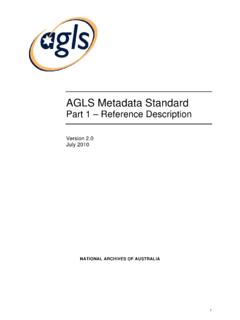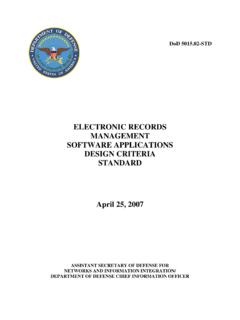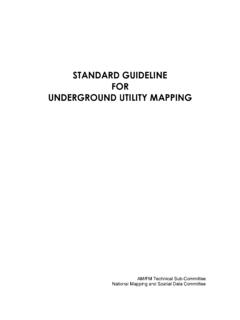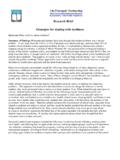Transcription of Better Life Index 2017 Definitions and metadata November …
1 November 2017 November 2017 This document defines the indicators included in the OECD Your Better life Index (BLI). Definitions for each indicator are listed by dimension of well-being, together with indications on the unit of measurement, the source and additional information available on the distribution. Income and Wealth Household net adjusted disposable income It's the maximum amount that a household can afford to consume without having to reduce its assets or to increase its liabilities. It's obtained, as defined by the System of National Accounts SNA, adding to people s gross income (earnings, self-employment and capital income, as well as current monetary transfers received from other sectors) the social transfers in-kind that households receive from governments (such as education and health care services), and then subtracting the taxes on income and wealth, the social security contributions paid by households as well as the depreciation of capital goods consumed by households.
2 Available data refer to the sum of households and non-profit institutions serving households (S14_S15). Unit of measurement: US dollars at current PPPs per capita1 Additional information: Socio-economic inequality (quintile 5 versus quintile 1) Sources: OECD calculations based on OECD National Accounts Statistics (database), and OECD Income Distribution and Poverty database (for socio-economic inequality) Household net financial wealth Net financial wealth consists of: currency and deposits, securities other than share, loans, shares and other equity (including shares issued by investment funds), insurance technical reserves, and other accounts receivable or payable, net of household financial liabilities, as defined by the System of National Accounts SNA.
3 Data refer to the sum of households and non-profit institutions serving households (S14_S15). Unit of measurement: US dollars at current PPPs per capita2 Sources: OECD calculations based on OECD National Accounts Statistics (database), 1 PPPs used are those for actual individual consumption 2 PPPs used are those for private consumption Better life Index 2017 Definitions and metadata 2 Jobs and earnings Employment rate It is the number of employed persons aged 15 to 64 over the population of the same age. Employed people are those aged 15 or more who report that they have worked in gainful employment for at least one hour in the previous week, as defined by the International Labour Organization ILO.
4 Unit of measurement: Percentage of the working-age population (aged 15-64). Additional information: Gender inequality (men versus women); Socio-economic inequality (educational attainment 5/6 ISCED group versus 0/1/2 ISCED group) Sources: Labour Force Statistics , OECD Employment and Labour Market Statistics (database), -data-en; OECD calculations based on Educational attainment and labour-force status , OECD Education at a glance (database) (for socio-economic inequality) Long term unemployment rate This indicator refers to the number of persons who have been unemployed for one year or more as a percentage of the labour force (the sum of employed and unemployed persons).
5 Unemployed persons are defined as those who are currently not working but are willing to do so and actively searching for work. Unit of measurement: Percentage of the labour force Additional information: Gender inequality (men versus women); Socio-economic inequality for the unemployment rate (educational attainment 5/6 ISCED group versus 0/1/2 ISCED group) Sources: Labour Force Statistics , OECD Employment and Labour Market Statistics (database), -data-en; OECD calculations based on Educational attainment and labour-force status , OECD Education at a glance (database) (for socio-economic inequality) Average gross annual earnings of full-time employees/ Personal earnings This indicator refers to the average annual wages per full-time equivalent dependent employee, which are obtained by dividing the national-accounts-based total wage bill (Wages and salaries SNA D11)
6 By the average number of employees in the total economy, which is then multiplied by the ratio of average usual weekly hours per full-time employee to average usually weekly hours for all employees (sourced from the Labour Force Suveys). It considers the employees gross remuneration, that is, the total before any deductions are made by the employer in respect of taxes, contributions of employees to social security and pension schemes, life insurance premiums, union dues and other obligations of employees. Unit of measurement: US dollars at current prices Additional information: Gender inequality (men versus women); Socio-economic inequality (percentile 80 versus percentile 20) Sources: OECD Average annual wages (database), and OECD estimates based on OECD National Accounts Database and Labour Force Surveys 3 Labour market insecurity This indicator is defined in terms of the expected earnings loss associated with unemployment.
7 This loss depends on the risk of becoming unemployed, the expected duration of unemployment and the degree of mitigation against these losses provided by government transfers to the unemployed (effective insurance). Unit of measurement: Percentage of previous earnings Sources: OECD Job quality (database), Housing Number of rooms per person/ Rooms per person This indicator refers to the number of rooms (excluding kitchenette, scullery/utility room, bathroom, toilet, garage, consulting rooms, office, shop) in a dwelling divided by the number of persons living in the dwelling. Unit of measurement: Rate (number of rooms divided by the number of people living in the dwelling) Sources: European Union Statistics on Income and Living Conditions (EU-SILC), National Statistical Offices and OECD's calculations Dwellings without basic facilities This indicator refers to the percentage of the population living in a dwelling without indoor flushing toilet for the sole use of the household.
8 Flushing toilets outside the dwelling are not to be considered in this item. Flushing toilets in a room where there is also a shower unit or a bath are also counted. Unit of measurement: Percentage of the population Sources: European Union Statistics on Income and Living Conditions (EU-SILC), National Statistical Offices Housing expenditure This indicator considers the expenditure of households in housing and maintenance of the house, as defined in the SNA (P31CP040: Housing, water, electricity, gas and other fuels; P31CP050: Furnishings, households equipment and routine maintenance of the house). It includes actual and imputed rentals for housing, expenditure in maintenance and repair of the dwelling (including miscellaneous services), in water supply, electricity, gas and other fuels, as well as the expenditure in furniture and furnishings and households equipment, and goods and services for routine maintenance of the house as a percentage of the household gross adjusted disposable income.
9 Data refer to the sum of households and non-profit institutions serving households (S14_S15). Unit of measurement: Percentage of the household gross adjusted disposable income Sources: OECD calculations based on OECD National Accounts Database 4 Health Status life expectancy at birth life expectancy measures how long on average people could expect to live based on the age-specific death rates currently prevailing. This measure refers to people born today and is computed as a weighted average of life expectancy for men and women. Unit of measurement: Number of years Additional information: Gender inequality (men versus women) Sources: Health status , OECD Health Statistics (database), Self-reported health status This indicator refers to the percentage of the population aged 15 years old and over who report good or Better health.
10 The WHO3 recommends using a standard health interview survey to measure it, phrasing the question as How is your health in general? with response scale It is very good/ good/ fair/ bad/ very bad 4. Unit of measurement: Percentage of the population Additional information: Gender inequality (men versus women); Socio-economic inequality (net disposable income5 quintile 5 versus quintile 1) Sources: Health status , OECD Health Statistics (database), Work and life Employees working very long hours This indicator measures the proportion of dependent employed whose usual hours of work per week are 50 hours or more.

















